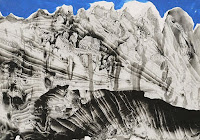 Enrico Donati: Decalcomania (81) and (82) [diptych], oil and tempera on paper, 16 x 12 1/2 inches (each), 1944
Enrico Donati: Decalcomania (81) and (82) [diptych], oil and tempera on paper, 16 x 12 1/2 inches (each), 1944As a supplement to our discussion of texture, I'd like to direct your attention toward a painting/drawing technique that was perfected by the Surrealists, called decalcomania:
"..a perfected form of a well-known children’s game, the ‘blotting’ game. Here the method was to pour diluted black gouache on to a sheet of white paper of a certain texture, covering this with another sheet and then execising uneven pressure with the hands, in order to spread the gouache. The result, always unpredictable, is a highly contrasted composition in black, grey and white, in which one can discover landscapes, profiles or heads, composite animals, [or] unknown plant life. […]Max Ernst conceived the idea of trying the experiment directly on a canvas, with oil paint reduced to a suitably fluid state. What began as a mere game suddenly seemed to him to offer rich possibilities…" (Patrick Waldberg)
I've included some examples below of how this technique was used by the master of the technique, Surrealist Oscar Dominguez, for you to consider the possibilities of organic texture:








